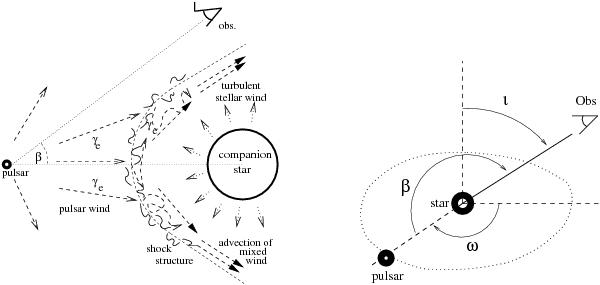Fig. 1

Schematic representation of the compact binary system containing a energetic MSP (on the left) and the picture on which the basic angles defining the binary system are shown (on the right). On the left: the pulsar creates a strong wind that contains relativistic electrons (γe). The companion star creates turbulent stellar wind mainly as a result of irradiation from the pulsar. The winds collide, creating a turbulent, non-stationary shock structure. Both winds mix effectively in this region. Relativistic electrons (from the pulsar wind or additionally re-accelerated in the turbulent pulsar-stellar winds) are isotropized by the random magnetic field of the mixed winds. They are advected along the shock structure. During this process, electrons comptonize stellar radiation producing γ-rays. Owing to the anisotropy of the stellar radiation field, γ-rays tend to be produced in the general direction of the companion star. As a result, the γ-ray signal, produced towards the observer (obs.) located at the angle β, should be modulated with the phase of the binary system. On the right: the binary system is inclined at the angle i towards the observer’s (Obs) line of sight. The orbital phase, ω, is equal to zero when the pulsar is in front of the companion star. The angle between the observer and the pulsar (and also injection place of relativistic electrons) is marked by β.
Current usage metrics show cumulative count of Article Views (full-text article views including HTML views, PDF and ePub downloads, according to the available data) and Abstracts Views on Vision4Press platform.
Data correspond to usage on the plateform after 2015. The current usage metrics is available 48-96 hours after online publication and is updated daily on week days.
Initial download of the metrics may take a while.




